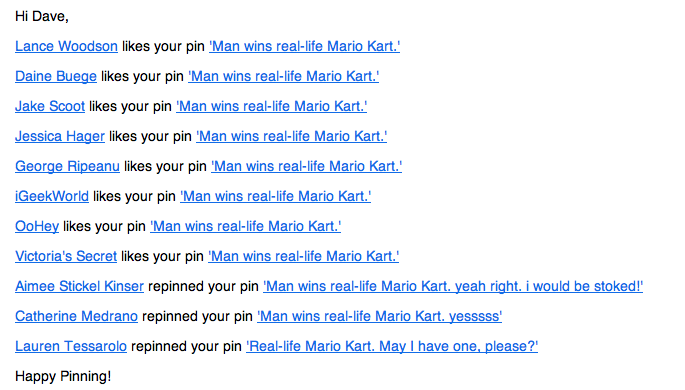My first clue that this “Victoria’s Secret” Pinterest account might not be what it purports to be was their liking of my pin about a man winning a real-life Mariokart:

I’m fine with brands engaging with users in this way, but this one felt a little off-brand to me.
I clicked to their profile, and everything seemed reasonably legit, except I noticed their URL is also a bit off-brand – there’s only one ‘s’, which I imagine is a big no-no over there, and there’s a trailing ‘l’ for no reason. The URL is: http://pinterest.com/victoriasecretl/. I’m not positive this isn’t Victoria’s Secret‘s official account, but this all gives me a strong suspicion. Another alternative, I suppose, is that the person administering the account “liked” my pin without realizing they were doing so from the corporate account. But I doubt VS would allow that URL to represent them even though http://pinterest.com/victoriassecret/ is being used by a regular person who got there first.
I don’t see any tell-tale affiliate monetization links in play here, but it would be easy enough for an affiliate marketer to pretend to be a brand, and then monetize all of the traffic they generate to that brand’s product pages using Pinterest as the middleman.
With all of the hype and traffic, it’s not surprising that enterprising brandjackers have started to take to Pinterest. There’s plenty of money and diverted traffic to be had there. This is perhaps an early warning sign that Pinterest needs to be smart, quickly, about ways to give brands a safe and profitable place to play in their sandbox if this is the next phase for their community. It’ll be interesting to see if they take any innovative approaches in this regard; sometimes clever systems and patterns emerge from challenges like these, like how pinboard.in uses a nominal registration fee (that slightly incremented each time a new user signed up, encouraging “real” people to jump in early) to keep out a certain significant cut of scammers and spammers for whom that would be a convenience barrier. There are some pre-existing patterns for them to follow from large social platforms but “Verified accounts,” for example, apparently quickly became a headache for Twitter to administer, and Facebook had a pretty significant infrastructure in place when they initiated that first gold rush for custom urls.
